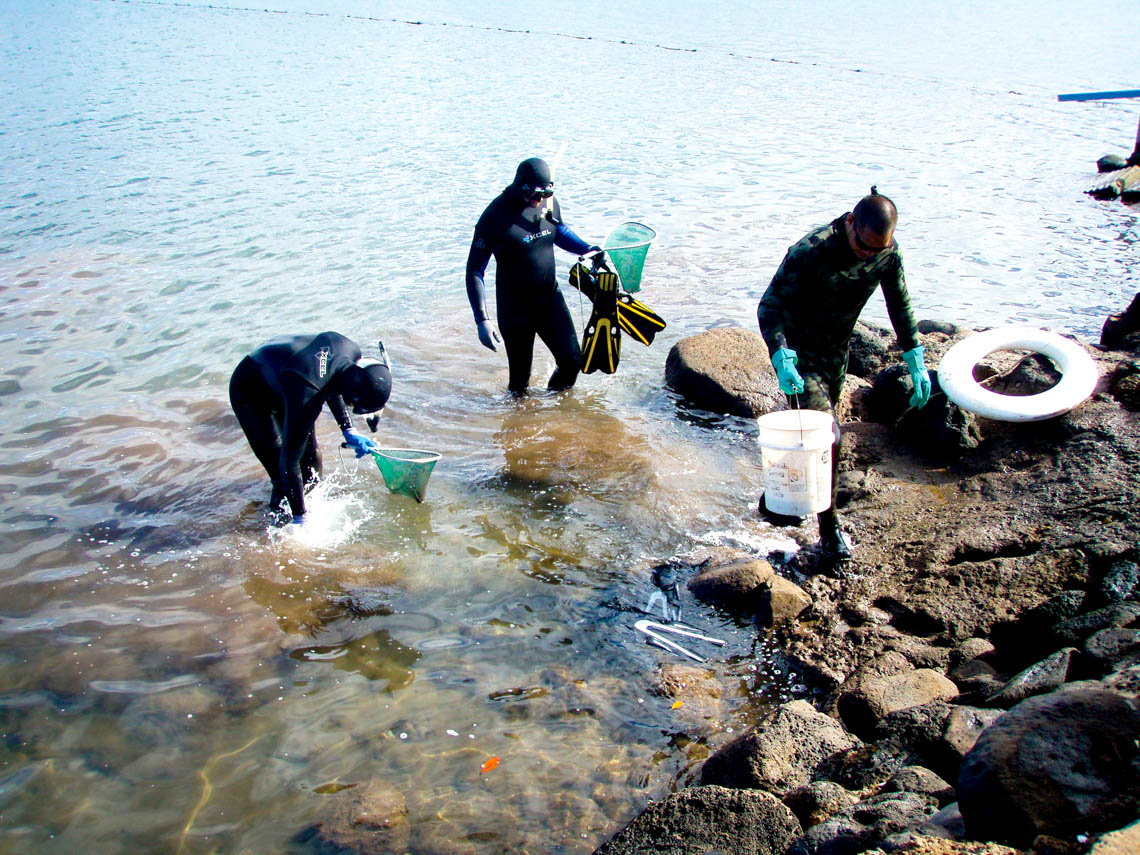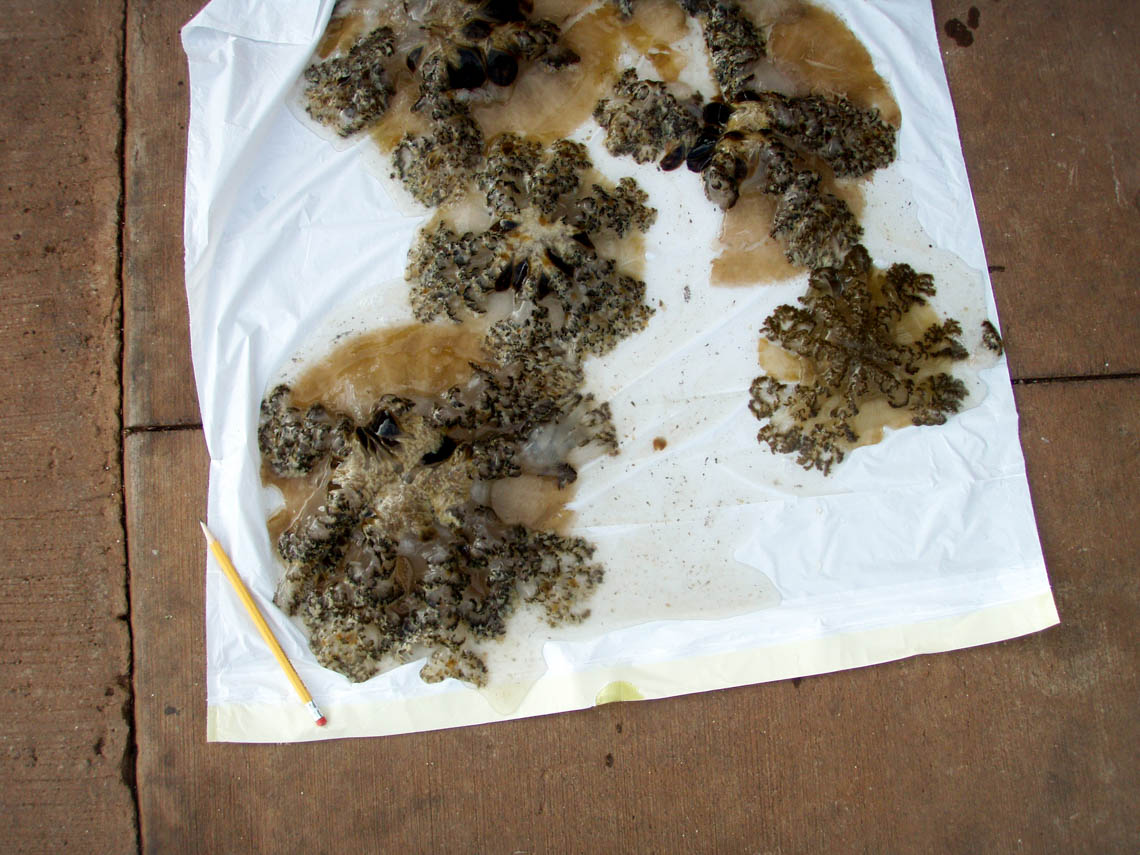
Back in 2009, a father and his two kids, still wet from the beach, walked into the office of the Molokai/Maui Invasive Species Committee. The kids were covered in welts. Dad carried a bucket containing a flat brownish thing. “This is stinging my kids,” he said.
He had captured an upside-down jellyfish, a relatively new creature in Hawaiʻi. The species anchors itself to the ocean floor upside-down, tentacles waving in the shallow water. “They look like big pancakes,” says Lori Buchanan, manager of the Molokai/Maui Invasive Species Committee (MoMISC).
For the jellyfish, this wrong-side-up strategy works: they use their bell as a foot to anchor themselves in place then, like coral, they partner with symbiotic algae that feed the jelly through photosynthesis. But these gelatinous blobs can pose problems for people in their midst: like many of their upright relatives, these jellyfish sting shooting harpoon-like nematocysts into the water when touched. When a single upside-down jelly stings, it can trigger the same reaction in his neighbors, leaving a stinging nematocyst floating in the water—a nightmare for snorkelers and swimmers.
The jellyfish delivered to Buchanan’s MoMISC office came from Kaunakakai Harbor–specifically, the roped-off swimming area that teemed with kids that summer. This was an urgent problem and Buchanan and her crew sprang into action to solve it.

With nets and buckets, the crew went to work, scooping jellies from the wharf. That first year, MoMISC crews removed 200 stinging jellies. They’ve kept at it, sometimes partnering with the crews from the Department of Natural Resources’ Division of Aquatic Resources. Visiting two to four times per year keeps the population down. Since their initial trip, they’ve removed 400 more of the squishy stingers.
These invasive jellyfish probably hitched a ride to Kaunakakai on the bottom of a boat – but that was not the first time they were seen in Hawaiʻi. First reported from Pearl Harbor in 1914, then in Kāneʻohe Bay, they likely arrived on the hull of a visiting ship, or as larvae in ballast water. They’ve invaded several places throughout the state, favoring shallow lagoons and fishponds where the water is calm.
Scientists believe the various populations resulted from at least two different introductions from far-flung places. Looking at the genetics of the different colonies, they traced one to Papua New Guinea and another to the Atlantic.
These spineless invaders are sometimes called mangrove jellyfish, for good reason. The two species are often found together. Here in Hawaiʻi, mangrove trees are invasive, and their presence can influence the population of upside-down jellyfish. As mangrove leaves break down in the water, they release chemicals that trigger larval jellyfish to settle down. The alien invertebrates then flip themselves over and rest in the shallow, clear water around mangroves. During MoMISC’s drive to remove the upside-down jellyfish, the crew noticed mangroves lining the wharf and removed them as well.
Without natural predators, these aquatic aliens can quickly cover an area. Buchanan says a fishpond on Molokai’s east end is so infested you can’t see its bottom.
Upside-down jellyfish have migrated from Pearl Harbor to Coconut Island in Hilo. So while Buchanan’s team won’t be able to remove them completely, it’s worth the effort to keep them suppressed in swimming areas. “The wharf is the most popular place on Molokai,” says Buchanan. “Especially in the summer, it’s like the mall.”
Aquatic invaders are no fun. You can help prevent them from spreading by keeping your boat free of hitchhikers. If you are interested in the role of hull-fouling and ballast water contamination in the spread of invasive species, check out this web page: http://dlnr.hawaii.gov/ais/ballastwaterbiofouling/ballastwaterdetails/
Lissa Strohecker is the public relations and education specialist for the Maui Invasive Species Committee. She holds a biological sciences degree from Montana State University. Kia’i Moku, “Guarding the Island,” is prepared by the Maui Invasive Species Committee to provide information on protecting the island from invasive plants and animals that can threaten the island’s environment, economy, and quality of life.
This article was originally published in the Maui News on September 10th, 2017, as part of the Kia‘i Moku Column from the Maui Invasive Species Committee.
Read more Kiaʻi Moku articles.
